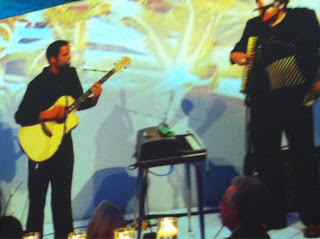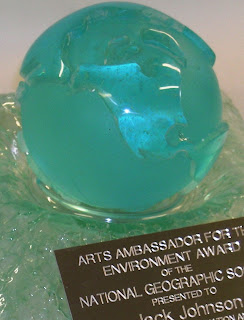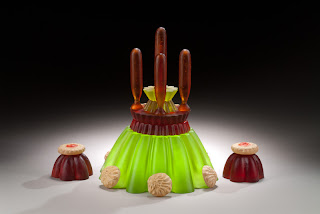>This posting is the first of a new feature for the Washington Glass School blog: ‘The Process’.
The occasional series will present a photo documentation of a project from start (or at least when we remembered to get a camera going) to finish, highlighting the steps, process and techniques involved. Mistakes, dramas, and screw-ups will be magically deleted from the documentation postings, naturally.
Our first of the series is a focus on the making of National Geographic’s newest award – the ‘National Geographic Arts Ambassador for the Environment Award’ . The recipient for the inaugural award is musician Jack Johnson.
Uber-mellow singer-songwriter-surfer-filmmaker Jack Johnson has dedicated himself to environmental causes, including educational initiatives and promoting eco-friendly touring in the music industry.
Musician and environmental activist Jack Johnson was to receive the newly created “Arts Ambassador for the Environment Award,” presented to an individual in the entertainment field who has demonstrated leadership in environmental and cultural conservation by elevating issues of sustainability and inspiring audiences to care about the planet. Jack Johnson grew up surfing and playing guitar in Hawaii. He released his first album in 2001 and, in the last ten years, has released 5 more albums that have sold over 20 million copies worldwide. In 2003, Jack and his wife Kim founded the Kokua Hawaii Foundation and Kokua Festival to support environmental education in Hawaii’s schools and communities. In 2008, Jack donated 100% of his tour profits to establish the Johnson Ohana Charitable Foundation, an endowment founded by Jack and Kim Johnson to support environmental, art and music education worldwide. These tour profits, along with Johnson’s personal charitable activities, have resulted in millions donated to charity since 2001.
In keeping with the environmental conscious theme, the National Geographic Society asked for an award that was made from recycled glass, and a number of designs were studied.

As the award was to be yearly, the concepts had to allow for art ambassadors that worked in areas of interest such as “oceans” or “forests” or “wildlife” and be able to relate equally to those themes. Early on, a globe shape was favored by the National Geographic award committee. Recycled float (window) glass was to be cast using the lost wax process. The National Geographic committee stipulates that the cast glass globe be removable, and options for the support base are explored.
The Process:
Spraying the clay original with a mold release agent.
Pouring the rubber mold compound around the original clay form.
After setting up – preparing to cut open the rubber mold and remove the clay form. After removal of the clay, melted wax is poured into the rubber mold, and a wax copy of that form is removed.
The wax original is coated with with layers of a plaster/silica mix, building up the form until a solid covering is achieved.
The plaster/silica form is allowed to set up. Once hardened, the wax is melted out – the essence of the ‘lost wax’ process.
Checking the mold for any wax residue.
Recycled float glass is cleaned and made ready for casting.
The molds are loaded into the electric kilns and glass placed into ceramic pot reservoirs. The glass globes go through a six day annealing cycle.
After the glass is cooled, the forms are removed from the kilns.
The molds are broken open, being mindful of the glass contained within.
Chipping away at the plaster mold.
The glass is cleaned and coldworked. Rough spots are ground and polished to a shine.
Robert Kincheloe evaluates the level of shine on the glass globe continents.
While the cast glass globe is being coldworked, the base for the globe and the award nameplate is being created. A custom ceramic mold is shaped and fired. A flat blank made from recycled glass is fused and made ready to slump into the ceramic mold.
The glass base is fired in the kiln and coldworked to receive the glass globe.
The base is fitted with a clear gasket to prevent chipping of glass.
Studio photos of the award and of the evening were promised by National Geographic – we will post once we get the shots!
About the National Geographic award night:
The theme of the National Geographic’s inaugural “Evening of Exploration” celebration was “Oceans,” and the event was attended by an all-star cast of explorers and other luminaries, including newly appointed National Geographic Explorers-in-Residence filmmaker James Cameron and marine ecologist Enric Sala, as well as other Explorers-in-Residence who presented the evening’s awards: oceanographer Robert Ballard, marine biologist Sylvia Earle, wildlife filmmakers Dereck and Beverly Joubert and population geneticist Spencer Wells.
In keeping with the environmental theme – the appetizers were made from “invasive species” – like snakehead fish sushi.
Besides Jack Johnson, the other honorees included: Environmental anthropologist Kenny Broad and the late underwater photographer Wes Skiles were named “Explorers of the Year,” a new award presented in recognition of their extraordinary achievements in exploring and documenting the Blue Holes of the Bahamas in 2010. The National Geographic “Chairman’s Award” was presented to IBM for significantly advancing knowledge of the world through its research partnership with National Geographic on the Genographic Project, which is mapping the migratory history of humans.
The master of ceremonies was Wolf Blitzer, CNN’s lead political anchor. Following the awards presentation, Johnson performed songs for the crowd.

Proceeds from the evening will benefit National Geographic’s Explorer programs, comprising the Explorers-in-Residence, Fellows and Emerging Explorers. The “Evening of Exploration” was the culmination of the two-day National Geographic 2011 Explorers Symposium, an annual event at which National Geographic Explorers-in-Residence, Fellows, Emerging Explorers, grantees and others affiliated with National Geographic gather to share findings of their research and fieldwork and take part in panel discussions.
Cast Glass Sweeties
>
Sugar Bomb #3; Cast glass, 2011
Debra Ruzinsky
Bombshell, 2011
Debra Ruzinsky‘s cast glass artwork was recently praised by the Washington Post Art Critic Michael O’Sullivan in a review of glass sculpture that was on exhibit at Long View Gallery. In the review, Michael wrote: “My guilty pleasure sits all the way in the back of the 5,000-square-foot gallery… There you’ll find two small sculptural works by artist Deborah Ruzinsky, mounted on pedestals in front of large glass doors that, on sunny days, suffuse the room with light. The works’ titles, “Sugar Bomb #2” and “Sugar Bomb #3,” are apt. Cast in green and orange glass using Jell-O molds and artillery shell casings, they’re pure, explosive eye candy.
Staring at it, I feel like a monkey in front of a ball of shiny, shiny tin foil. Isn’t contemporary art supposed to be ugly — or at least less superficial?…
On the one hand, glass is pretty. It’s hard not to like the way it looks: the luminous color, the way it plays with light. On the other hand, maybe glass is only pretty. How do we know that the beauty is also capable of brains? The rest of the show is proof that it is.”
Debra checks her cast glass wafer ramp for smoothness.
Check back later for links to the Brattleboro Museum show.
Boro Casting
>
A casting kiln loaded with boro.
Robert Kincheloe has been developing a method of casting using borosilicate glass (aka “hard” glass or 33 C.O.E or Pyrex) and creating components that can later be assembled into Flameworked sculpture.
Rob Kincheloe prepping the glass to be invested into the molds.
Here Rob had made plaster/silica molds via the “lost wax casting” process, and is now loading into the kiln, investing with boro glass.
His process of merging warm and hot glass practices creates one of a kind sculptural works of art.
“Crashing” the kiln to take the glass out of devit range.
The red-hot glass at 2100º F
Some of the cast boro elements – showing the translucent colors. These elements will later be flameworked into sculpture.
Upcoming Class in the "Lost Wax" Process
>
One of the most sought after glass techniques – Lost Wax Casting is coming soon to the Washington Glass School!
This is a great way to make 3-D elements in kilncast glass. Think of the sculptural possibilities!
Glass guru Tim Tate uses this technique to make sculptural glass elements that are part of his blown & cast glass reliquary artworks. The detail and control of of the form allows for the creation incredible works of art.
A view of some of Tim Tate’s cast glass elements made with the lost wax process.
Our instructor for this class, Debra Ruzinsky, was on the Rochester Institute of Technology (RIT) faculty as Asst Professor of Glass, and has just come back from teaching this technique at the Studio at the Corning Museum of Glass.
Debra Ruzinsky works with the students on preparing the plaster encasement.
Have a look at the course description below – this could be the most interesting class you take this year!
Class 1021 – Basics of Lost Wax Casting
In this 3 day class we will make a sculptural vessel form in the “lost wax” method. Students will begin with a pre-made wax form that they learn to carve and alter. Students are asked to research surface design ideas prior to starting, bringing sketches, magazine clippings, xerox’s, etc.

Example of student lost wax work.
Lost Wax – Found!
Inside The Kiln: Lost Wax
>
Erwin Timmers checks out the lost wax firing
Debra Ruzinsky’s “Introduction to Lost Wax Casting” class started off with great success – the art works will continue firing and annealing in the kiln until Wednesday. Shown here is Erwin Timmers as he checks on the work to ensure the integrity of the plaster casts and the glass levels in each mold during the process. Although the mathematics to determine of the amount of glass needed to fill the molds were practiced – some were more precise in their calculations than others.
Great New Addition to the Glass School
>
Our newest instructor at the glass school is Debra Ruzinsky. Debra recieved her BA in design from the University of Californina at Los Angeles, and her MFA in Glass Sculpture from Rochester Institute of Technology (RIT). She has been working in glass since 1982. She serves on the publications committee of the Glass Art Society, and was Visiting Asst. Professor of Glass at RIT for the 2008 – 2009 academic calendar year. She has previously taught at the University of Oregon Craft Center, and will teach at the Studio at Corning in 2010.
Her work is part of the collection of the Seto City Museum in Seto, Japan, and the Glasuseet Ebeltoft in Denmark, as well as the RIT Wallace Library Purchase Prize Collection, and some private collections. In the summer of 2008 she was an invited artist-in-residence at the Seto City International Ceramic and Glass Art Exchange program in Seto, Japan. She was included in the 2009 MFA Exhibition at Urban Glass in Brooklyn, NY and Breakthrough Ideas in Global Glass at Hawk Galleries in Columbus, OH through Fall 2009.
Debra will be teaching Introduction to Lost Wax Casting this Fall session & we welcome her to the Washington arts community! Click HERE to jump to her website.

















